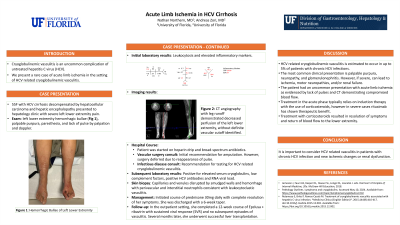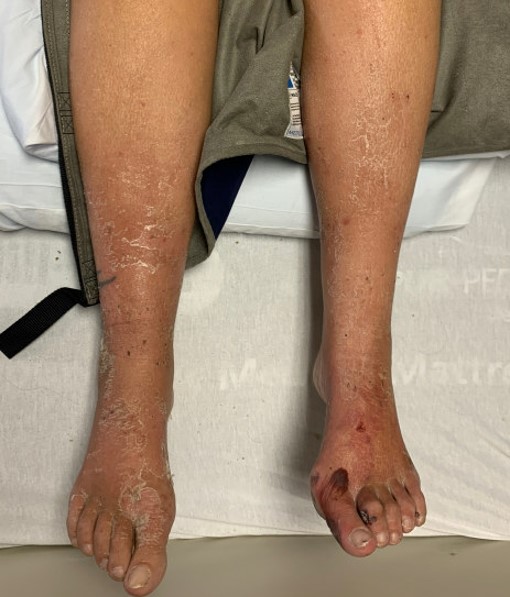Monday Poster Session
Category: Liver
P3152 - Acute Limb Ischemia Due to Cryoglobulinemia in HCV Cirrhosis
Monday, October 28, 2024
10:30 AM - 4:00 PM ET
Location: Exhibit Hall E

Has Audio
- NN
Nathan Northern, MD
University of Florida College of Medicine
Gainesville, FL
Presenting Author(s)
Nathan Northern, MD, Andreas Zori, MD
University of Florida College of Medicine, Gainesville, FL
Introduction: Cryoglobulinemic vasculitis is an uncommon complication of untreated hepatitis C virus (HCV). We present a case of acute limb ischemia in the setting of HCV related cryoglobulinemic vasculitis.
Case Description/Methods: A 55-year-old female with a history of cirrhosis due to untreated HCV complicated by hepatocellular carcinoma and hepatic encephalopathy presented to clinic with severe left lower extremity pain for which she was admitted to the hospital. Upon arrival, the patient was found to have left lower extremity hemorrhagic bullae, palpable purpura, paresthesia, and lack of pulse by palpation and doppler as seen in figure 1. Initial laboratory results demonstrated leukocytosis and elevated inflammatory markers. CT angiography leg runoff demonstrated decreased perfusion of the left lower extremity. The patient was started on heparin drip, steroids, and broad-spectrum antibiotics. Vascular surgery initially recommended amputation. However, prior to surgical intervention lower extremity pulses returned and the plan transitioned to medical management. Further laboratory evaluation showed elevated serum cryoglobulins and low C3 and C4 complement factors. A skin biopsy demonstrated leukocytoclastic vasculitis. Steroid therapy resulted in complete symptom resolution with subsequent discharge. Following the hospitalization, she was treated with Sofosbuvir/Velpatasvir resulting in sustained viral response and no recurrence of vasculitis.
Discussion: HCV related cryoglobulinemic vasculitis is estimated to occur in up to 5% of patients with chronic HCV infections. Its most common clinical presentation is palpable purpura, neuropathy, and glomerulonephritis. However, if severe, it can lead to ischemia, motor neuropathies, and/or renal failure. This patient had an uncommon presentation with acute limb ischemia as evidenced by lack of pulses and CT angiography imaging of affected limb with compromised blood flow. Treatment in the acute phase typically relies on induction therapy with the use of corticosteroids, however in severe cases rituximab has been shown to have some therapeutic benefit. In this case, the patient responded well to corticosteroids with resolution of her symptoms and return of blood flow to her foot. She was later able to undergo definitive antiviral treatment for her HCV with no further recurrences of her HCV related vasculitis. It is important to consider cryoglobulinemic vasculitis in patients with chronic HCV infection and new findings of ischemia.

Disclosures:
Nathan Northern, MD, Andreas Zori, MD. P3152 - Acute Limb Ischemia Due to Cryoglobulinemia in HCV Cirrhosis, ACG 2024 Annual Scientific Meeting Abstracts. Philadelphia, PA: American College of Gastroenterology.
University of Florida College of Medicine, Gainesville, FL
Introduction: Cryoglobulinemic vasculitis is an uncommon complication of untreated hepatitis C virus (HCV). We present a case of acute limb ischemia in the setting of HCV related cryoglobulinemic vasculitis.
Case Description/Methods: A 55-year-old female with a history of cirrhosis due to untreated HCV complicated by hepatocellular carcinoma and hepatic encephalopathy presented to clinic with severe left lower extremity pain for which she was admitted to the hospital. Upon arrival, the patient was found to have left lower extremity hemorrhagic bullae, palpable purpura, paresthesia, and lack of pulse by palpation and doppler as seen in figure 1. Initial laboratory results demonstrated leukocytosis and elevated inflammatory markers. CT angiography leg runoff demonstrated decreased perfusion of the left lower extremity. The patient was started on heparin drip, steroids, and broad-spectrum antibiotics. Vascular surgery initially recommended amputation. However, prior to surgical intervention lower extremity pulses returned and the plan transitioned to medical management. Further laboratory evaluation showed elevated serum cryoglobulins and low C3 and C4 complement factors. A skin biopsy demonstrated leukocytoclastic vasculitis. Steroid therapy resulted in complete symptom resolution with subsequent discharge. Following the hospitalization, she was treated with Sofosbuvir/Velpatasvir resulting in sustained viral response and no recurrence of vasculitis.
Discussion: HCV related cryoglobulinemic vasculitis is estimated to occur in up to 5% of patients with chronic HCV infections. Its most common clinical presentation is palpable purpura, neuropathy, and glomerulonephritis. However, if severe, it can lead to ischemia, motor neuropathies, and/or renal failure. This patient had an uncommon presentation with acute limb ischemia as evidenced by lack of pulses and CT angiography imaging of affected limb with compromised blood flow. Treatment in the acute phase typically relies on induction therapy with the use of corticosteroids, however in severe cases rituximab has been shown to have some therapeutic benefit. In this case, the patient responded well to corticosteroids with resolution of her symptoms and return of blood flow to her foot. She was later able to undergo definitive antiviral treatment for her HCV with no further recurrences of her HCV related vasculitis. It is important to consider cryoglobulinemic vasculitis in patients with chronic HCV infection and new findings of ischemia.

Figure: Figure 1: Physical exam findings of left lower extremity hemorrhagic bullae and palpable purpura.
Disclosures:
Nathan Northern indicated no relevant financial relationships.
Andreas Zori indicated no relevant financial relationships.
Nathan Northern, MD, Andreas Zori, MD. P3152 - Acute Limb Ischemia Due to Cryoglobulinemia in HCV Cirrhosis, ACG 2024 Annual Scientific Meeting Abstracts. Philadelphia, PA: American College of Gastroenterology.
